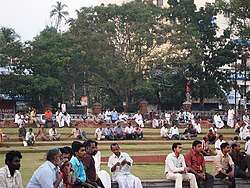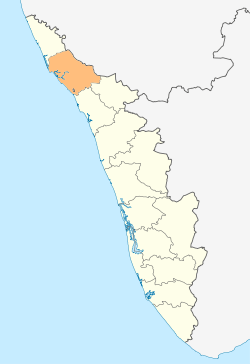Kannur district
| Kannur District Cannanore District Crown of Kerala | |
|---|---|
| District | |
 People in Kannur | |
 Location in Kerala | |
| Coordinates: 11°52′08″N 75°21′20″E / 11.8689°N 75.35546°ECoordinates: 11°52′08″N 75°21′20″E / 11.8689°N 75.35546°E | |
| Country |
|
| State | Kerala |
| Headquarters | Kannur |
| Government | |
| • District Collector | Mir Mohamad Ali IAS |
| • District Police Chief | Sri. G. Siva Vikram IPS |
| Area | |
| • Total | 2,966 km2 (1,145 sq mi) |
| Languages | |
| • Official | Malayalam, English |
| Time zone | UTC+5:30 (IST) |
| ISO 3166 code | IN-KL-KNR, IN-KL |
| Vehicle registration | KL-13, KL-58, KL-59 |
| Sex ratio | 1090 ♂/♀ |
| Literacy | 95.10% |
| Website |
www |
Kannur District is one of the 14 districts along the west coast in the state of Kerala, India. The town of Kannur is the district headquarters and gives the district its name. The old name, Cannanore is the anglicised form of the Malayalam name "Kannur". Kannur district is bounded by Kasaragod District to the north, Kozhikode district to the south and Wayanad District to the southeast. To the east the district is bounded by the Western Ghats, which forms the border with the state of Karnataka (Kodagu district). The Arabian Sea lies to the west. Paithalmala is the highest point in the Kannur District (1,372m). Enclosed within the southern part of the district is the Mahé district of the Union Territory of Puducherry. The district was established in 1957.
Kannur is the sixth-most urbanized district in Kerala, with more than 50% of its residents living in urban areas. Kannur has an urban population of 1,212,898, which is the second largest in Kerala after Ernakulam district.[1][2]
History
Kannur was an important trading center in the 12th century with active business connections with Persia and Arabia. It served as the British military headquarters on India's west coast until 1887. In conjunction with her sister city, Tellicherry, it was the third largest city on the western coast of British India in the 18th century after Bombay and Karachi. St. Angelo Fort was built in 1505 by Dom Francisco de Almeida, the first Portuguese Viceroy of India.The Dutch captured the fort from the Portuguese in 1663. They modernised the fort and built the bastions Hollandia, Zeelandia and Frieslandia that are the major features of the present structure. The original Portuguese fort was pulled down later. A painting of this fort and the fishing ferry behind it can be seen in the Rijksmuseum Amsterdam. The Dutch sold the fort to king Ali Raja of Arakkal in 1772. The British conquered it in 1790 and used it as one of their major military stations on the Malabar Coast. During the 17th century, Kannur was the capital city of the only Muslim Sultanate in the malabar region, known as Arakkal.[3] During the British Raj, Kannur was part of the Madras province in the North Malabar District.
Government and politics
Panoor, Kuthuparamba and Mattanur areas of Thalassery Taluk in the district have been a hub of political violence between the Communist Party of India (Marxist) (CPI(M)) and the Hindus-led Rashtriya Swayamsevak Sangh (RSS) combine. Clashes in 2008 left seven people killed and many have been injured. The High Court of Kerala called this manslaughter a “compelling sport” and suggested permanent deployment of Central forces in the affected areas.[4]
Demographics
According to the 2011 census Kannur district has a population of 2,525,637,[6] roughly equal to the nation of Kuwait[7] or the US state of Nevada.[8] This gives it a ranking of 170th in India (out of a total of 640).[6] The district has a population density of 852 inhabitants per square kilometre (2,210/sq mi).[6] Its population growth rate over the decade 2001-2011 was 4.84%.[6] Kannur has a sex ratio of 1133 females for every 1000 males,[6] the highest among any district in India, and a literacy rate of 95.41%.[6]
The District has a population of 2,412,365 (2001 census). This was the most urbanised district in Kerala in 2001, but was pushed to 4th place after Ernakulam, Thrissur and Kozhikode in 2011.[9] About 50.35% of the population reside in the urban agglomerations. The total urban population of Kannur district is 1,212,898. This is the second largest urban population in Kerala after Ernakulam and is more than the population of a metro city.[10]
The high urban population is due to the 45 towns in the district which was the highest in Kerala as per 2001 census. 2011 census has Thrissur with 135 towns with Kannur having 67.[11] Kannur district has seven statutory towns: Kannur, Kannur Cantonment, Thalassery, Payyannur, Thaliparamba, Kuthuparamba and Mattannur. In addition to this there are 60 including Ancharakandy, Azhikode North, Azhikode South, Chala, Chelora, Cherukunnu, Cheruthazham, Chirakkal, Chockli, Dharmadom, Elayavoor, Eranholi, Iriveri, Kadachira, Kadirur, Kalliasseri, Kanhirode, Kannadiparamba, Kannapuram, Kottayam-Malabar, Mavilayi, Munderi, Muzhappilangad, Narath, New Mahe, Paduvilayi, Pallikkunnu, Panniyannur, Panoor, Pappinisseri, Pathiriyad, Pattiom, Peralasseri, Peringathur, Pinarayi, Puzhathi, Thottada, Valapattanam, Varam.[9]
Notable people
- E. Ahamed - Former Minister of State for Railways
- Salim Ahamed - Film director, screenwriter, film producer
- Athmiya - Actor
- Sukumar Azhikode - Writer
- N. E. Balaram - one of the founding leaders of the communist movement in Kerala
- Kaithapram Damodaran - Lyricist, music director, actor, singer, screenwriter, and performer of Carnatic music
- Deepak Dev - Music composer
- M. V. Devan - painter, sculptor, writer, art critic and orator
- Jimmy George - Volleyball player
- A. K. Gopalan - Politician, former leader of the Communist Party of India (Marxist)
- T. Govindan - former Member of Parliament
- K. Karunakaran - Former Chief Minister of Kerala and Congress leader
- Shamna Kasim - Actor
- Shajith Koyeri - Sound designer
- Sushin Shyam - Music composer
- Nikhila Vimal - Actor
- Vineeth Kumar - Actor
- Major General CK Lakshmanan - First Malayali Olympian
- Sruthi Lakshmi - Actor
- Tintu Lukka - Athlete
- V. K. Krishna Menon - nationalist, diplomat, and politician
- Geetu Mohandas Actor
- Mamta Mohandas - Actor
- Malavika Mohanan- Actor
- C. P. Krishnan Nair - Businessman and founder of Leela group of hotels
- Bejoy Nambiar- Director and Screenwriter
- M. N. Nambiar - Actor
- K. P. P. Nambiar - Industrialist and technocrat
- Madhushree Narayan - Playback singer
- Ramesh Narayan - Music composer
- E. K. Nayanar - Former three time Chief Minister of Kerala
- T. Padmanabhan - Writer
- Ronald Lynsdale Pereira - Admiral from the Pereira family of Burnacherry Kannur
- Azhikodan Raghavan - Politician
- K. Raghavan - Music composer
- Shaan Rahman - Music composer
- M. V. Raghavan - Former minister
- Pazhassi Raja - Ruler of the Pazhassi Kingdom in present-day Kannur District
- Kannur Rajan - Music composer
- T.V. Rajesh - Politician
- Kadannappalli Ramachandran - Minister of Port of Kerala
- Moorkoth Ramunni - Fighter pilot
- Sanjayan - Writer
- Mattannoor Sankarankutty - Percussionist
- Sanoop Santhosh - Actor
- V. P. Sathyan - Footballer
- C.K. Vineeth - Footballer
- P. K. Sreemathy - MP
- Sreenivasan - Actor
- Dhyan Sreenivasan - Actor
- Vineeth Sreenivasan - Actor, singer, film director
- Samvrutha Sunil - Actor
- Nivetha Thomas - Actor
- Pinarayi Vijayan - Former CPIM State Secretary and Chief Minister of Kerala.
- Vineeth - Actor
- Manju Warrier - Actor (originally from Thrissur, lived in Kannur during her schooling)
See also
References
- ↑ http://urbanindia.nic.in/theministry/subordinateoff/tcpo/pop_name/ANNEX-CONCEPTS_DEFINITIONS.pdf
- ↑ "Untitled Document".
- ↑ Arakkal royal family Archived 2012-06-05 at the Wayback Machine.
- ↑ "Only Centre can end Kannur violence: High Court". Chennai, India: The Hindu. 12 March 2008.
- ↑ "Kannur District Religion Census 2011". census2011.co. Retrieved 28 April 2018.
- 1 2 3 4 5 6 "District Census 2011". Census2011.co.in. 2011. Retrieved 2011-09-30.
- ↑ US Directorate of Intelligence. "Country Comparison:Population". Retrieved 2011-10-01.
Kuwait 2,595,62
- ↑ "2010 Resident Population Data". U. S. Census Bureau. Archived from the original on 2011-08-23. Retrieved 2011-09-30.
Nevada 2,700,551
- 1 2 "Census of India Website : Office of the Registrar General & Census Commissioner, India". Archived from the original on 2007-05-14.
- ↑ "Archived copy". Archived from the original on 2010-01-11. Retrieved 2009-08-27.
- ↑ http://www.censusindia.gov.in/2011-prov-results/paper2-vol2/data_files/kerala/Chapter_IV.pdf
External links
| Wikimedia Commons has media related to Kannur district. |
| Wikivoyage has a travel guide for Kannur District. |